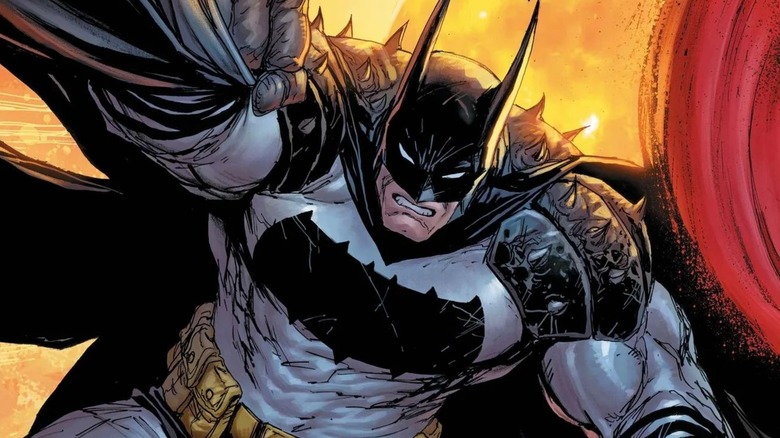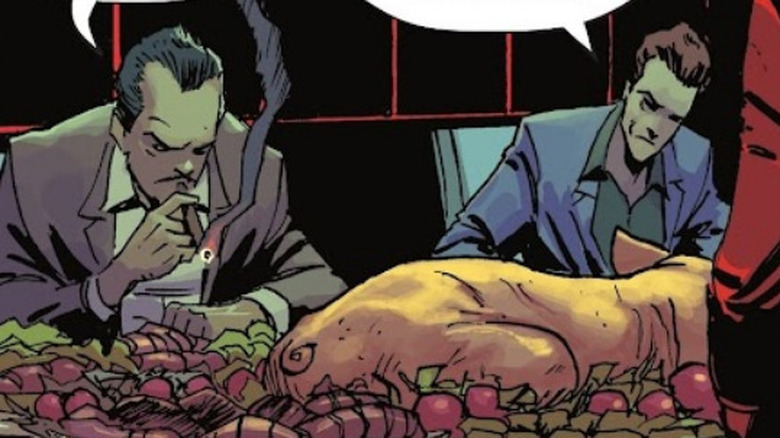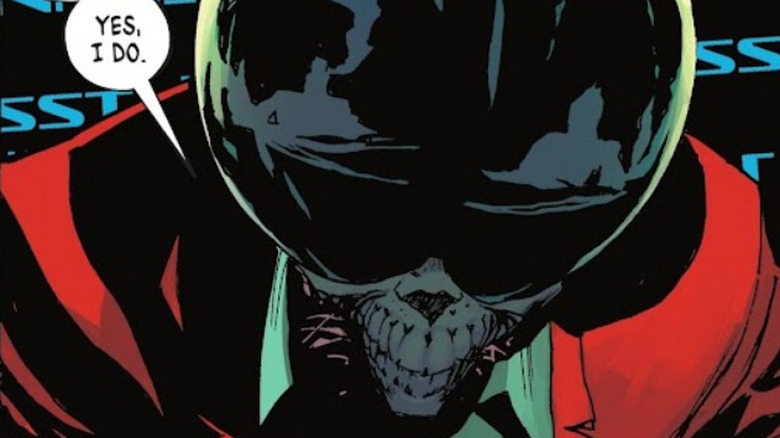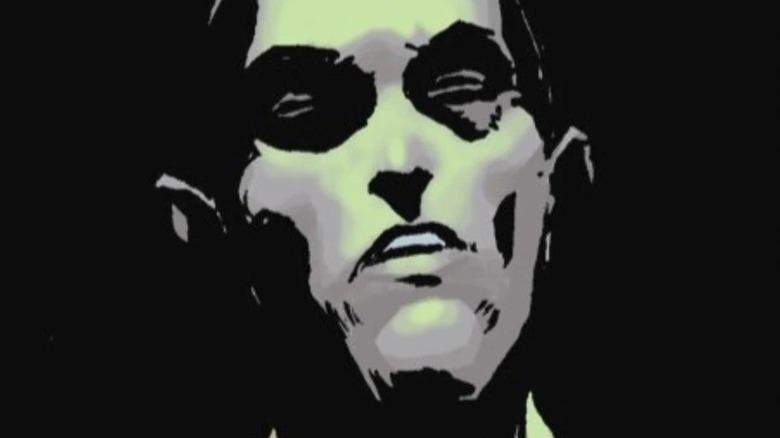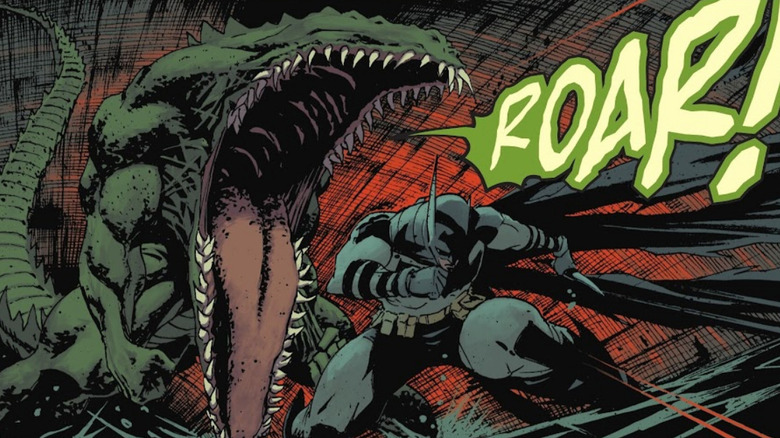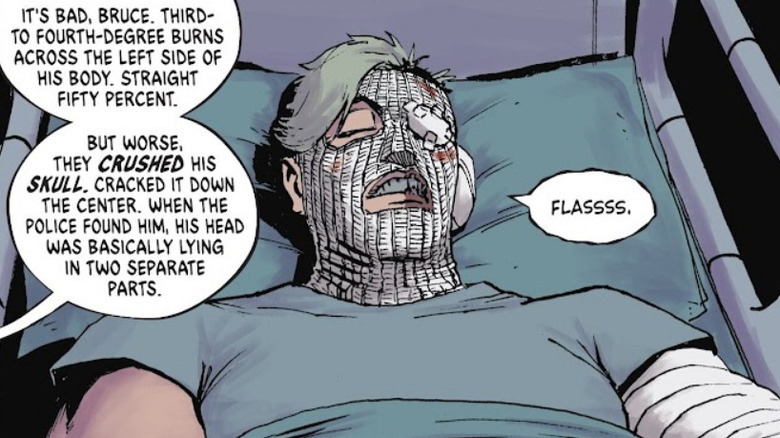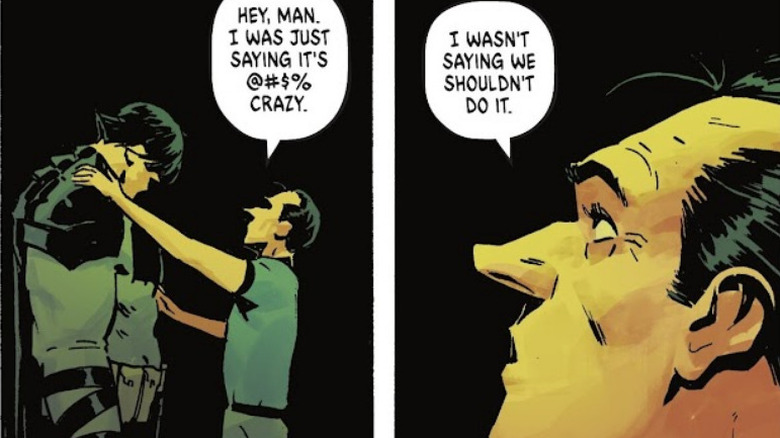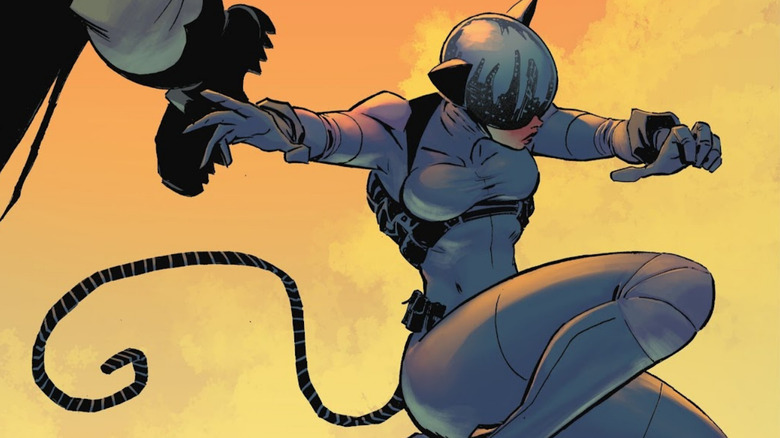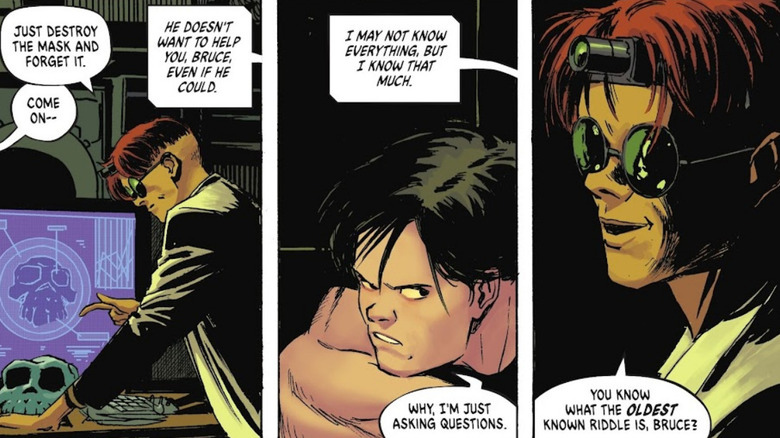All The Major DC Comics Villains In Absolute Batman (So Far)
"Absolute Batman" has hit the comic book world like a bat-shaped battle axe. Created by writer Scott Snyder and artist Nick Dragotta, it's a bold, brawny re-imagining of the classic Batman mythos that challenges everything you know about the Caped Crusader. DC Comics published "Absolute Batman" #1 in October 2024 and it became its bestselling comic book of that year – and it's still going strong.
The Absolute Universe is a brand-new continuity cleaved from the mainline DC Universe. The evil despot Darkseid warped this reality to bend towards chaos and injustice; the DC Universe's greatest superheroes are now underdogs with new origins. Superman grew up on the doomed planet Krypton, Wonder Woman was raised in Hell instead of Themyscira, and Batman is an engineer whose working class parents were never shot in Crime Alley. No longer a billionaire playboy, "Absolute Batman" envisions the Dark Knight as a bone-breaking hero of the streets, fighting the wealthy elites who have turned Gotham City into their twisted playground.
But Batman isn't alone in Gotham City, and "Absolute Batman" has revamped and revitalized the supervillains who make up his legendary rogues gallery. While some villains closely resemble their original counterparts, others are nearly unrecognizable, with striking new character designs and surprising ties to Bruce Wayne's past. Pull up your red hoods and strap into the new Batmobile, because we are going to talk about every major villain who has appeared in "Absolute Batman" so far.
The Falcone and Maroni crime families
Before Gotham City was ruled by monsters and madmen, it was run by the mafia. As seen in classic comic stories like 1987's "Batman: Year One" (and the 2022 film partially inspired by it, "The Batman") Carmine Falcone is the reigning "godfather" of organized crime in Gotham, and one of Bruce Wayne's first targets as the Dark Knight. Salvatore Maroni is a rival mobster best known for throwing acid in Harvey Dent's face, transforming him into Two-Face. The Falcone and Maroni families meet their end in "Batman: The Long Halloween," their criminal empires destroyed by the Holiday Killer.
"Absolute Batman" disposes of Falcone and Maroni much more quickly. In issue #1, the mob bosses meet the mysterious Black Mask on his mega-yacht, ordering him to stop encroaching on their criminal territory and to leave the city by dawn. Instead, Black Mask displays his collection of historical death masks, revealing the faces of executed Falcone and Maroni relations among them. Falcone and Maroni are then gruesomely executed by Black Mask's henchmen. In both the mainline DC and Absolute universes, the deaths of these powerful mob bosses signifies the end of an era in Gotham City and the rise of the costumed supervillain.
Black Mask
With his talent for torture, Black Mask is arguably the most sadistic villain to ever cross paths with Batman. Making his debut in 1985's "Batman" #386, Roman Sionis is born into wealth and privilege. Sionis puts on a mask and takes on a new identity, but unlike Batman, he commits crimes instead of stopping them. Black Mask rules Gotham's underworld and leads the False Face Society, a gang of masked hoodlums.
The Roman Sionis introduced in "Absolute Batman" #1 is similar to his mainline DC Universe counterpart. An exceptionally wealthy crime lord who operates from his mega-yacht, Sionis is sent by the Joker to destabilize Gotham City and enable the construction of the Ark M black site. Sionis is also the mastermind behind the Party Animals, a gang of masked, hedonistic killers who attempt to murder Mayor Jim Gordon. In issue #6, Batman fights Black Mask in brutal hand-to-hand combat and blinds Sionis with the sharp, mechanical ears on his cowl. Throwing him off the yacht, Batman permanently ends Black Mask's killer party.
Joe Chill
The DC Universe has its share of powerful villains, from the world-crushing Anti-Monitor to Parallax, the living embodiment of fear, but perhaps the most significant villain in DC history is simply a man with a gun. Joe Chill is the criminal who attempts to rob Thomas and Martha Wayne in Crime Alley and (in a scene that has been immortalized in almost every piece of Batman media, beginning with "Detective Comics" #33 in 1939) fatally shoots them in front of their young son, Bruce. Joe Chill is the man who created Batman.
In "Absolute Batman" #1, Joe Chill is a mass shooter who opens fire at the Gotham Zoo while Bruce Wayne is on a school trip. Thomas, their teacher, heroically hides his students inside the bat enclosure, but is slain by Chill. In issue #4, Bruce speaks at Chill's trial, with the traumatized boy condemning his father's murderer and leaving before Chill can give his statement. Chill remains incarcerated, and several years later an adult Bruce — now the vigilante known as Batman — visits him in prison to finally hear what he has to say. Joe Chill is the specter of violence haunting Bruce Wayne across the multiverse.
Killer Croc
Killer Croc holds a special place in Batman's rogues gallery — in a fraternity of colorful kingpins and evil geniuses, Killer Croc is a big guy who looks like a crocodile. Debuting in "Detective Comics" #523 in 1983, Killer Croc is Waylon Jones, a wrestler and sideshow performer born with a reptilian skin condition and superhuman strength. Bullied for his strange looks, Killer Croc is depicted as little more than an animal who relies on brute force, though later appearances have been more humanizing.
In the Absolute Universe, Waylon "Croc" Jones is a former professional fighter, the owner of Croc's Gym, and Bruce Wayne's best friend. Waylon grew up in Crime Alley and was on the ill-fated school trip at Gotham Zoo where Thomas Wayne was killed. He gets kidnapped in "Absolute Batman" #8 and taken to Ark M, where he is transformed into a gigantic reptilian creature. Retaining his human intelligence, he helps Batman escape the facility. Horrified by his transformation, Waylon asks Batman to kill him, but he refuses to harm his friend and Waylon retreats into Gotham's sewers.
Bane
Bane will be forever famous as the supervillain who "broke the Bat." Introduced in the 1993 comic "Batman: Vengeance of Bane" #1, Bane hails from the Caribbean island Santa Prisca. As a child, Bane is condemned to carry out his revolutionary father's life sentence; growing up inside the prison, he trains his mind and body to become the ultimate warrior. In the 1993 story "Knightfall," Bane is addicted to the experimental, strength-enhancing drug Venom, and he breaks Batman's back over his knee, temporarily paralyzing him.
The Absolute Universe follows Bane's origin on Santa Prisca, with a key exception. Upon his escape from prison, as seen in "Absolute Batman" #11, he encounters the billionaire known as the Joker. The Joker pledges to use his power to bring peace to war-torn Santa Prisca — if Bane acts as his right hand. Experiments with the drug Venom turn him into a grotesquely huge and unstoppable killing machine. This Bane also wants to break Batman, but instead of his spine, he aims for his heart, brutally beating Bruce's closest friends.
Two-Face
What makes Two-Face one of Batman's most dangerous enemies? The fact that he was once Batman's friend. Two-Face is introduced in 1942's "Detective Comics" #66 as an idealistic district attorney whose face is partially-scarred after a mobster flings acid at him. Driven insane, he becomes the villain Two-Face. Modern interpretations of Harvey Dent portray him as experiencing dissociative identity disorder: "Harvey" is an ally to Bruce Wayne, while "Two-Face" is a criminal mastermind, and they decide between good and evil based on a coin toss.
In the Absolute Universe, Harvey is a lawyer at City Hall and the "big brother" of Bruce's friend group. He is appalled when Bruce reveals his secret identity as a masked vigilante to his friends, but he uses his connections to help Batman fight the Party Animals. In issue #12, Harvey tries to stop Bane from attacking his friends, but Bane, correctly identifying Harvey as a man living between two worlds, cracks his skull perfectly in half and burns 50% of his body. Harvey berates Bruce in the hospital for gambling with his friends' lives, but then admits that he only hates him "half the time."
The Penguin
For a supervillain named after a flightless bird, the Penguin is one of Batman's most ruthless and persistent foes. Real name Oswald Cobblepot, the Penguin first appeared in 1941's "Detective Comics" #58 and is a gentleman criminal whose alias originates from his short, round, and birdlike appearance. He is also infamous for his use of deadly trick umbrellas, which conceal weapons as varied and deadly as a machine gun and a rocket launcher.
Absolute Oswald Cobblepot looks more like the version played by Robin Lord Taylor in the "Gotham" TV series than Danny DeVito or Colin Farrell's prosthetic-heavy performances. A Crime Alley kid turned small-time criminal, Oz projects himself as a big man to hide his insecurity about his height. In "Absolute Batman" #6, Bruce explains his double life to his friends, and they agree to help infiltrate the Ark M black site. Oz is nervous about their plans, even suggesting they flee Gotham, and his fears are proven correct. Issue #12 reveals that Oz is in hospital after Bane breaks nearly every bone in his body, and Dr. Leslie Thompkins explains that he will be in constant pain and two feet shorter for the rest of his life.
Catwoman
The definitive femme fatale of the DC Universe, Catwoman has more than nine lives. Selina Kyle made her debut in 1940's "Batman" #1 as a sultry cat burglar, beginning a flirtation with Batman that grows into a decades-spanning, star-crossed love affair. Catwoman's entire backstory can get a little complicated, but the short version is that she develops from an amoral jewel thief to a whip-cracking protector of the downtrodden in Gotham City.
The Absolute version of Selina Kyle is first glimpsed in issue #1, with flashbacks establishing her as an acrobatic foster kid with a fondness for cats. She is especially close to Bruce, and in issue #3, she cheers him up after his father's death by leading him to a secret screening of "Zorro." Selina and Bruce fall in love, with the troubled young man helping her commit burglaries. They eventually part ways, and Selina becomes Catwoman, a globe-trotting masked mercenary.
Selina returns to Gotham in issue #12 to check on Bruce, fully aware of his double life as Batman. Their passion instantly reignited, Batman and Catwoman go on a "date" to the abandoned theme park housing the Red Hood. An expert fighter and marksman, Catwoman dispatches gang members with knock-out darts. She is horrified to witness Batman's body changing from the effects of the Venom drug forcibly given to him at Ark M. She warns Batman not to rely on Venom when he challenges Bane again, which causes a rift between the once-and-future lovers.
The Riddler
Batman is the world's greatest detective, and no single rogue challenges that label more than Edward Nygma, the Riddler. First appearing in 1948 in "Detective Comics" #140, the Riddler is a criminal genius known for his flamboyant question mark-themed wardrobe and his obsession with puzzles and riddles. Driven by his overinflated ego, the Riddler frequently leaves clues at crime scenes to prove he can outsmart Batman — with predictable results.
In "Absolute Batman," Eddie Nygma is Bruce's childhood friend and a tech genius. In issue #3, Eddie introduces AL, a partially-assembled android made as a receptacle for all human knowledge. The stereotypically nerdy Eddie also claims to have figured out that Bruce is Batman before everyone else. Following Bane's attack, Eddie is the only one of Bruce's friends who isn't hospitalized, but that doesn't mean he is unharmed.
After beating him in a riddles contest, Bane gouges out Eddie's eyes and damages his frontal lobe in issue #12. According to Eddie, "suddenly facts became questions," and he dissembles AL to build a cybernetic skull around his exposed brain. To Bruce's horror, Eddie says he is grateful to Bane for helping him become what he was meant to be.
Mr. Freeze
The cold-blooded villain Mr. Freeze has a long history with Batman. He first appeared in 1959's "Batman" #121 as "Mr. Zero" and was a minor ice-themed foe until "Batman: The Animated Series" reintroduced him in the classic 1992 episode "Heart of Ice." In that tragic origin story (later incorporated into the comics), Mr. Freeze is Dr. Victor Fries, a scientist obsessed with curing his cryogenically-frozen wife Nora's terminal illness. Due to a laboratory accident, Mr. Freeze cannot survive outside of sub-zero temperatures and wears a specially-designed cryo-suit.
Mr. Freeze's analogue in the Absolute Universe is actually the son of Victor and Nora Fries. Together they founded the company V-Core, which cryogenically-preserves people with deadly diseases. Introduced in "Absolute Batman" #7, Victor Jr. is the only sick person to be successfully revived at V-Core. However, the agonizing freezing process warps his psyche and the prehistoric bacteria in the ice mutates his body, allowing him to transform into a wraith-like monster.
The adult Victor Jr. becomes CEO of V-Core and freezes wealthy donors seeking immortality. When Bruce Wayne's friend Matches Malone infiltrates V-Core and uncovers its ties to Ark M, Victor kills him via deadly bacteria, unknowingly incurring Batman's wrath. In issue #8, the monstrous Victor unsuccessfully tries to kill Batman by reviving his frozen patients, who are now mindless zombies.
Harley Quinn
Harley Quinn is one of the biggest superstars in the DC Universe, so her dramatic entrance in "Absolute Batman" was only a matter of time. "Batman: The Animated Series" introduced Harley in the 1992 episode "Joker's Favor" as the Joker's adoring gun moll, and her rise over the decades from fan-favorite minor villain to the star of comic books, video games, movies, and an animated series is nothing less than meteoric (here's Looper's ranking of every screen version of Harley Quinn). In the mainline DC Universe, Harley's real identity is Dr. Harleen Quinzel, a former psychologist at Arkham Asylum who escapes a toxic relationship with the Joker to become a colorful, mallet-wielding anti-hero.
Absolute Harley Quinn is introduced in issue #13 as the leader of the Red Hood, an outlaw collective operating in an abandoned seaside carnival. The Red Hood has an uneasy alliance with Batman, and when he announces his intention to burn down the Ark M black site, Harley agrees to help. Sporting a shaved head rather than iconic blonde pigtails, Harley wears a red-hooded sweatshirt like the other members of her gang, sports black diamond makeup and tattoos, and wields a pair of nunchuks. In the mainline DC Universe, Red Hood originated as a criminal alias of the Joker, but, as the leader of the Red Hood in the Absolute Universe, Harley Quinn shows right away that she is nobody's sidekick.
The Joker
More than just Batman's archenemy, the Joker is one of the most recognizable comic book villains in pop culture history. The sick and twisted Clown Prince of Crime first appears in 1940's "Batman" #1, with his dark sense of humor functioning as a foil to Batman's stoic demeanor. The Joker has no definitive name or origin, and he has been alternately portrayed as a gimmicky prankster, a sociopathic killer, and the embodiment of insanity itself.
The Absolute Universe is a reality where the status quo tilts toward evil and injustice. In "Absolute Batman" #1, the Joker is a mysterious, jet-setting billionaire playboy with a secret identity — a twisted reflection of Bruce Wayne in the mainstream DC Universe. Called "The Joker" because he never laughs, he is said to have trained with Henri Ducard and the League of Assassins (before killing them) and provides the money behind Black Mask and Ark M.
Absolute Joker nominally appears as a handsome, dark-haired man, but "Absolute Batman" #6 reveals his true appearance: He's a skeletal, bone-white being with green veins who needs bizarre blood transfusions from infants to look "normal." Batman and Joker have yet to meet face to face in this universe, but cover art for the upcoming issue #15 shows that the Joker is even more monstrous than he appears.
The Ark M inmates
Arkham Asylum is one of the most iconic locations in the entire Batman mythos, possibly eclipsed only by Wayne Manor and the Bat Cave. First appearing in 1974's "Batman" #258, it takes its name from the works of horror writer H.P. Lovecraft. It operates as a psychiatric home for the criminally insane, with an infamously high escape rate among its most notorious patients. The concept of "Arkham Asylum" has been modernized in "Absolute Batman." Arks are private prisons funded by the Joker's company J.K. Holdings, with the latest, Ark M, under construction in Gotham. In keeping with Arkham's Lovecraftian origins, Ark M is a massive underground compound that subjects its detainees to horrific genetic experiments, turning them into monsters.
"Absolute Batman" #10 contains several references to major DC villains, but whether they are seeds for future story arcs or simply Easter eggs is unknown. Batman passes by a giant mass dubbed the "Helfern Experiment," in reference to Kyle Helfern, the mad scientist Doctor Death. He then stumbles into the "K.L.A.Y. biome," a writhing mass of malformed patients similar to Clayface. Karl Langstrom, a scientist who transforms himself into Man-Bat, is mentioned, and Batman discovers what appears to be a skeleton of a man-bat hybrid. A corridor is named after the villain Hugo Strange, and the Isley ecosystem — named after Pamela Isley, aka Poison Ivy — is a nightmarish forest of twisted tree people.
